Running Analysis / Injuries
At The Reinge Clinic we have huge experience working with runners of all levels to achieve their goals.
Whether you are just starting out or are at the elite level, looking for the edge, we can use our Sports Science and Biomechanical knowledge to help you achieve your goals and we do this with a Running Analysis.
Why have a running analysis?
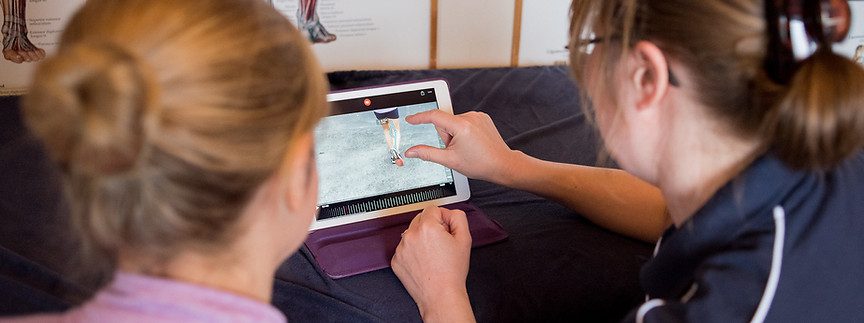
The way you run can hugely affect your run times as well as your chances of getting an injury.
When your foot hits the floor in running, you get a ground reaction force that comes up through your body. That ground reaction force can help you, it can make you run more efficiently, or it can hinder you and slow you down.
That force can cause your knees, hips, back and even shoulders to move fluidly together, or they can work against you, creating injuries for the future.
This is why a running analysis is an essential part of your pre race preparation, and we do this using video technology.
What happens during the Running Analysis?
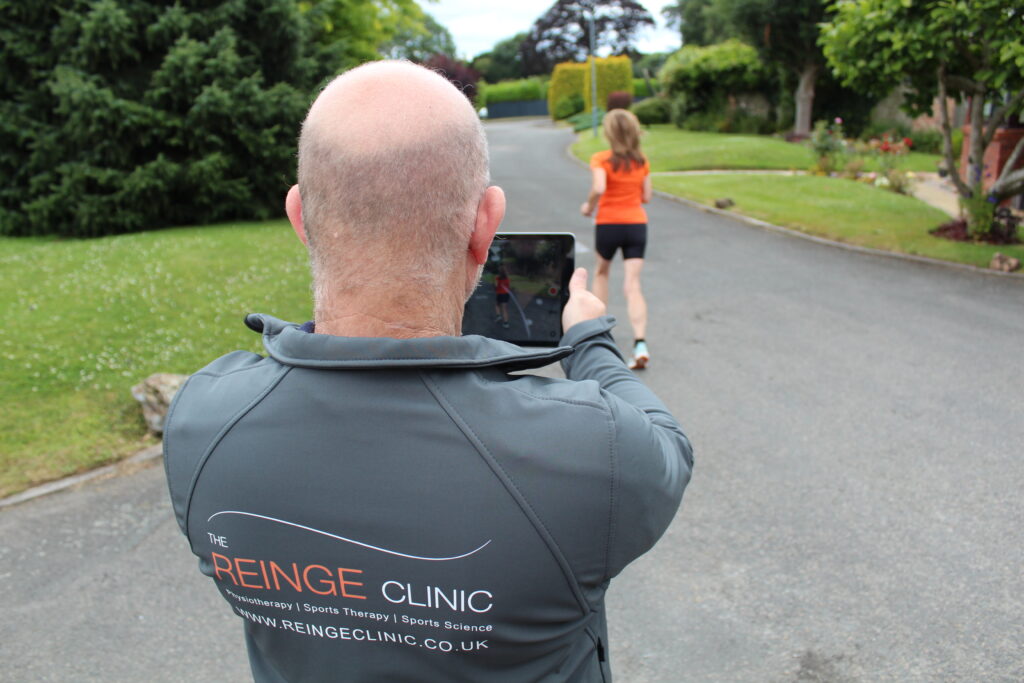
Our running analysis initial session lasts 90 minutes. During this time we will assess your posture and analyse how you run. We use video technology to video you running out in the real world. This allows us to see how your foot strikes the floor, as well as the effect this has throughout your body, all the way from your feet to your head.
Along with your history and our physical assessment, this allows us to change your running style. The aim being to improve your efficiency of running and therefore your run times, to get rid of a running injury, or to prevent you getting injured in the future. Within our running analysis session we ask you to run in all of your shoes and we give you advice on the best shoes for you. Everyone is an individual so one shoe type does not work for everyone
What can we do for running injuries?
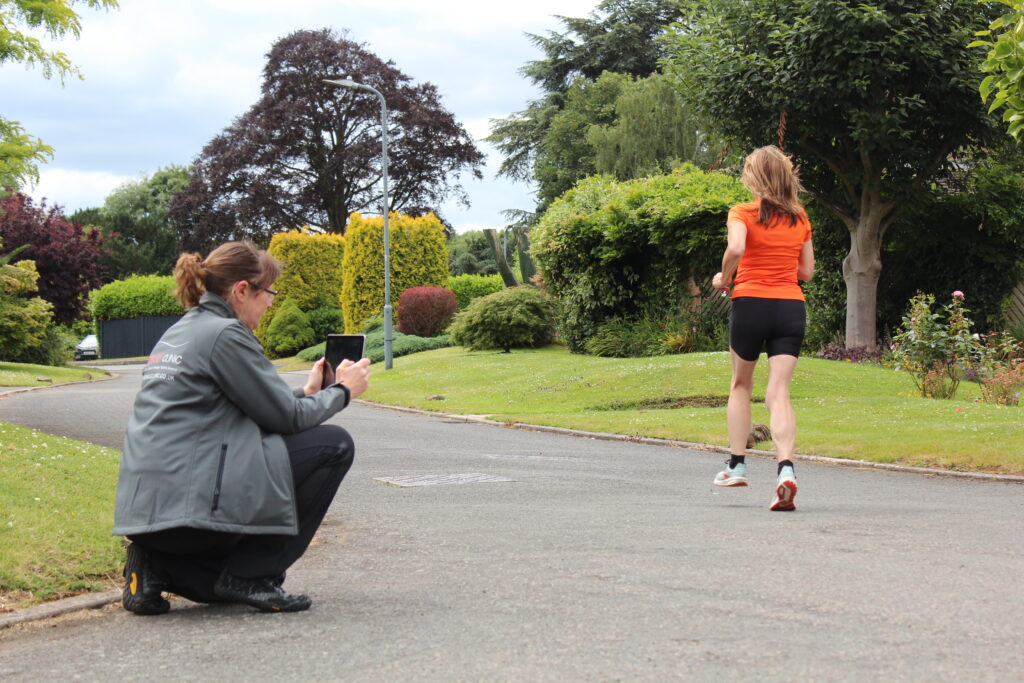
Running injuries often come from the way your foot strikes the floor. There are a lot of forces involved in running and these forces travel up through the leg and affect the knees, hips and even the back. This is why we will always perform a video running analysis when we assess a running injury.
When we assess a running injury, we start by assessing the joint or muscle in question. We are looking for balance across the lower body, so we will often measure the circumference of your legs, to work out whether you are loading one leg more than another.
We will always check out your feet when you come to us with a running issue. This is the only point of contact with the floor during running, and where all the ground reaction forces occur that actually propel you when you run. Having weak feet or ankles will affect how these forces are dissipated throughout the body and are often the cause of running injuries.
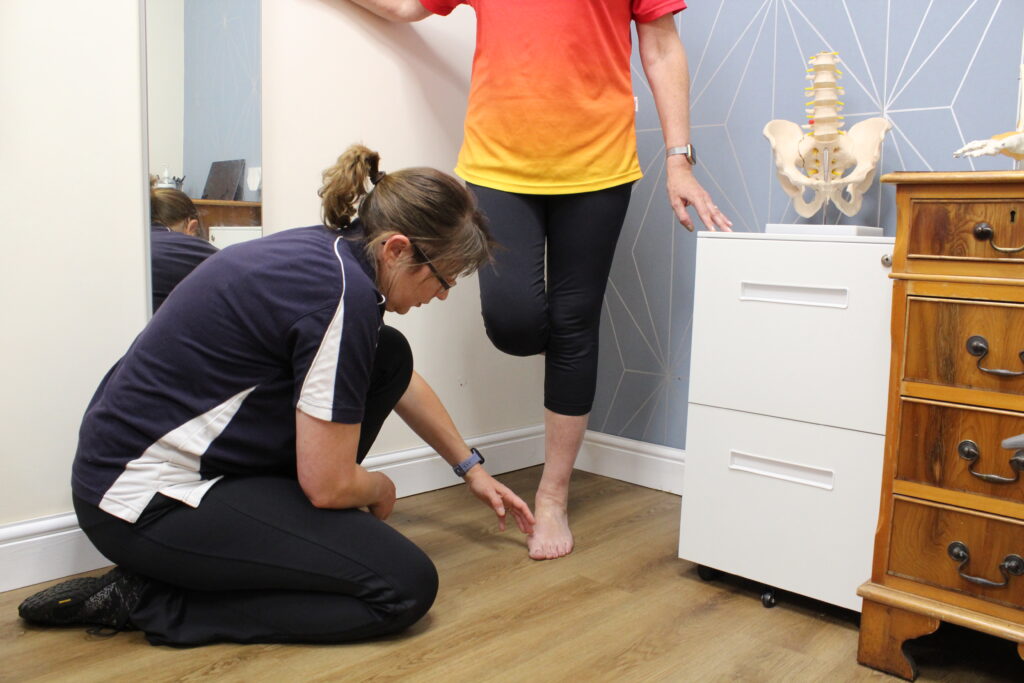
We will then take a look at your running shoes. This allows us to assess the tread of your current shoes to get an idea of how your foot hits the floor. Next we take you outside and ask you to run while we video you. This usually allows us to understand why you got injured in the first place and work out how to, both fix your current injury, and stop it recurring at a later date.
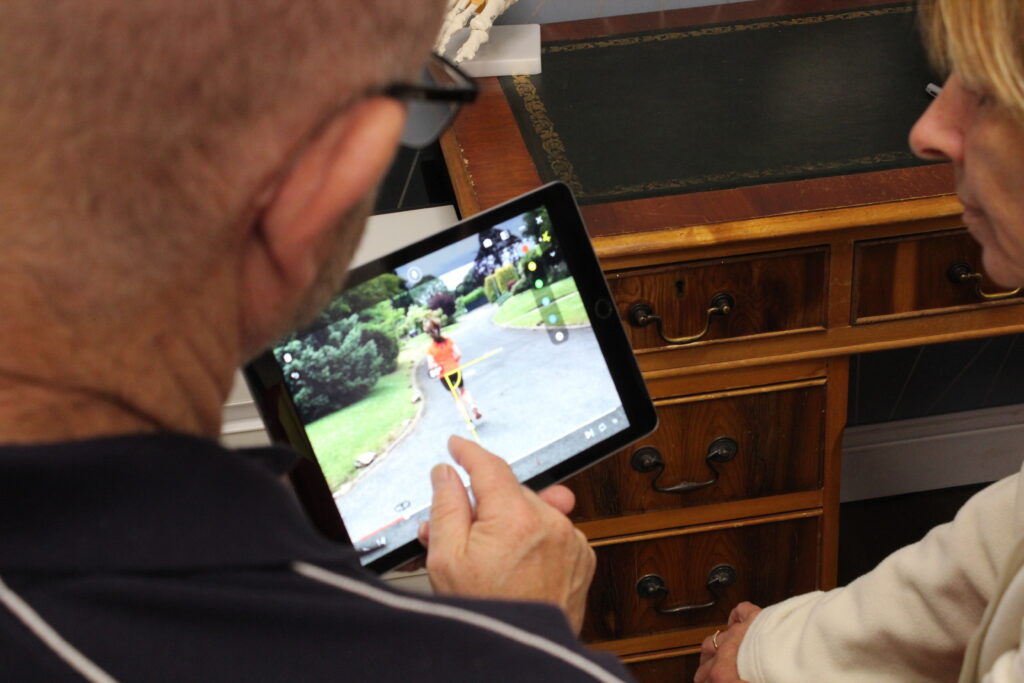
Clients find this element of our assessments fascinating as the way they see themselves on the video, is usually very different to how they thought they were running.
Finally we set you up with a strengthening program and show you how to alter your gait to solve your running injury for the long term.
Frequently Asked Questions about Running Analysis
Please bring all your shoes, many runners have several pairs and we may need to see you run in all of them.
Please also bring whatever you usually run in, and ideally a pair of short shorts so we can assess the whole lower body.
Our initial running analysis session is 1.5hrs long.
This gives us plenty of time to video you, assess your muscle firing and body biomechanics. As well as time to provide strength exercises and alter your Running Gait if needed.
All our Running follow up appointments are 50 minutes long and we will usually do a quick video recheck of your running at that point.
Our Running Analysis initial Assessment lasts 1.5hrs and costs £120. Our follow up sessions are 50 minutes long and cost £76.
For running injuries you can book for either session depending how complex you feel your issue is. If you are unsure, get in touch and we can help.
We get you to run in the real world rather than on a treadmill. The mechanics of running on a treadmill are very different to running in the real world. Most people run out in the real world, so this is where we assess you.
We aren’t running coaches, but we are Sports Scientists. We have been trained to look at the way the body works and understand the forces involved and how the muscles deal with those forces.
In their younger days, Ian used to be a triathlete and Gina a runner with Coventry Godivas Running Club, so we have a very real understanding of running and running injuries.
Gina is a member of BASES (British Association of Sport and Exercise Scientists) ensuring they stay up to date with the latest research.
You can book using our online booking system. Or you can email us or call us directly.
We don’t use receptionists, so when you call or email you get directly either Ian or Gina, who can answer any questions you may have about your condition, prior to making a booking.
Many insurance companies will cover the cost of running injuries and we work with many insurance companies.
If you wish to use insurance please ensure you contact us so we can arrange the correct authorisation.
Please note many insurance companies will only cover treatment by a Chartered Physiotherapist, if this is the case with your insurance you will need to book in with Ian rather than Gina. Ian is our chartered Physiotherapist.
What Our Clients Say About Us
Zoe Statters
October 20, 2022
Always upbeat, friendly, offers useful advice & service is always top notch, suggestions and treatments that actually work!
Barry Elkington
September 5, 2023
I went to the clinic for a running gait assessment with Ian. No specific injury problems, but from the wear on my running shoes I knew there was something not quite right. A very professional approach to not only analysing my style but also identifying the cause of the problem. Suggested exercises provided which should help, and the offer to review again in a few months if I sent a video. Couldn't really have asked for more.
John Hayden
September 5, 2023
I attended the Reinge Clinic with a back problem and painful right hip caused by some rather over enthusiastic running. Gina immediately identified the underlying cause and over three sessions together with her recommended exercises the problems have been resolved. A very friendly and professional service. I would definitely recommend the clinic.
Simon Perkin
September 5, 2023
I was introduced to Gina & Ian, the owners, who are in the process of transferring their long established business in Bristol to Kenilworth in Warwickshire. A few weeks earlier, I had a calf strain & over the years, my calfs have tended to be tight with me pulling my calf 18 months ago & some 10 years or so. Despite this, I have managed to get back, ran a half marathon in 1.29, 5k in sub 20 minutes & represented my country at 5k, 1500m & 800m. I have, however, always worried about calf niggles. I went to see Ian in his impressive Kenilworth practice. He did both a running gait & complete assessment, a bit of treatment & recommended no running for 6 weeks & 2 specific exercises which would take me no more than 10 minutes each day. I did not need to see Ian again but was determined to get back running & preferably injury free. Over the next 6 weeks, I continued with the exercises & started walking. After easing back into the running, I can now confidently report that I have ran 3 park runs in sub 22 minutes, jogged 2 hours & my calfs feel so good. As a precaution, I will book in to see Ian again in the next few days. What I like most about both Gina & Ian is that they are professionals, on your side & wanting to get to the root cause of the real problem; something many other health professionals just don't do. I can fully recommend both Gina & Ian. Thank you for your advice & support.
Debbie Cooper
September 5, 2023
I began seeing Gina towards the end of 2020 due to having severe back pain. I have a lower lumbar fusion and 2 slipped discs. After a thorough inspection and assessment Gina was able to begin her diagnosis and spec out a plan for me. At the point of first meeting Gina I was in so much pain that I could barely be touched and now I am able to train, run and cycle again without feeling pain. I am now undergoing running assessments to understand where my issues are, how to rectify them safely and set realistic goals.
Ciprian Ormenisan (Chip)
September 5, 2023
I used The Reinge Clinic to help me with my gait as I was training for the London Marathon. My running technique was all wrong, but with their help, it improved significantly, and I finished my first marathon at the age of 46. The sports massages kept me in top form and free from injuries. I would give them 5 stars and will definitely return to them in the future!
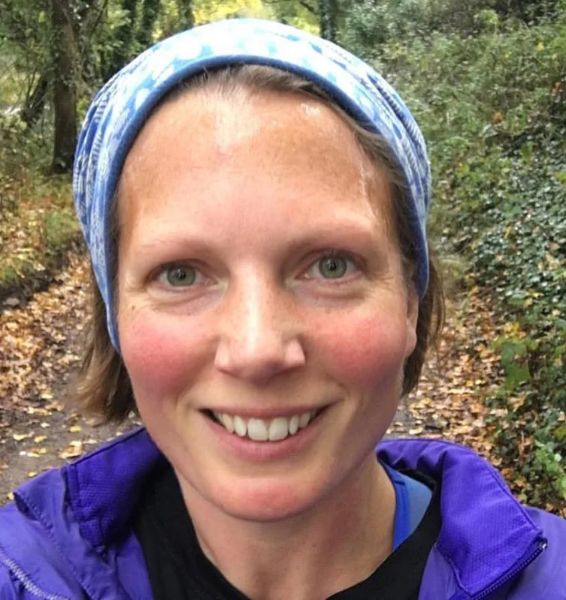
Lesley Waldron
September 5, 2023
Gina has become my ‘go to’ therapist for all my training niggles and injuries as well as for many of my clients. I enjoy her no nonsense approach that addresses so much more than the specific joint or muscle causing me discomfort. I tend to learn a lot from each appointment and I am convinced it has helped both my running as well as my own work with personal training clients. Gina keeps me running and keeps me working – both of which I love, so I thoroughly recommend her. I even recommend a visit even if you’re not injured! She can help you improve your posture and technique as well as help with race recovery.
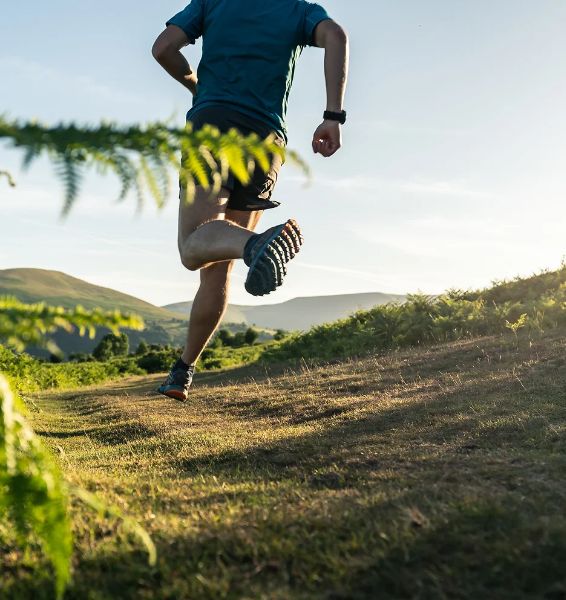
Jason Lammie - Ultra Runner
September 5, 2023
My injuries were compounded after seven years of throwing money at Physiotherapists. Running was painful and nowhere near the pace I was. I rang Ian in March with the view that it would be a few months out of running. Ian performed a gait assessment and identified the issue immediately. Although I have a long road ahead, I have run more monthly mileage than I have for the past three almost four years… He’s worked nothing short of a miracle. I would recommend this clinic over most in the region & I’ve been to a few.

Erik Downey - GB Triathlon
September 5, 2023
As a G.B. Age group Triathlete I have used Ian’s services for several years. He is very efficient at finding the cause of the problem and also treating the symptoms. I initially sought help for stress fractures and with his assistance was able to overcome these and compete in 6 Ironman events without any major injury issues. During my build phase I would attend Ian’s clinic on a monthly basis to ensure my body was given a once over. Ian would be able to spot minor issues and imbalances before they became a problem allowing to continue my training. Thank you Ian for helping me achieve my goals. The only advice I can give is don’t delay seeing Ian as the problem is unlikely to go away on its own.
Learn more about Running Analysis & Injuries
These videos were created to help our runners during the Covid 19 lockdowns.